 Old, But Still Useful!
Old, But Still Useful!
This old WWII military training video is still useful regarding Morse code:
[embedyt]https://www.youtube.com/watch?v=YqTn-165orw[/embedyt]
This is an antique United States Navy Training Film from 1943/1944, in which proper hand-sending of Morse code is demonstrated. The film covers some basic principles and mechanics of manual keying of the International Morse code, as used during WWII.
Amateur (Ham) radio operators find Morse code (and the ‘CW’ mode, or ‘Continuous Wave’ keying mode) very useful, even though Morse code is no longer required as part of the licensing process. Morse code is highly effective in weak-signal radio work. And, preppers love Morse code because it is the most efficient way to communicate when there is a major disaster that could wipe out the communications infrastructure.
While this military film is antique, the vintage information is timeless, as the material is applicable to Morse code, even today.
There’s more about Morse code, at my website: http://cw.hfradio.org
For additional joy, here are a few of old films regarding Morse code:
Morse Code – Principles and Basic Techniques (US Army Signal)
(Learn to Send Perfect Morse Code by Hand – Vintage Training Film (Ham Radio / CW))
[embedyt]https://www.youtube.com/watch?v=qmg1MlstxWM[/embedyt]
Vintage 1944 Radio Operator Training: How to Send Morse Code (CW) by Hand
[embedyt]https://www.youtube.com/watch?v=XjupJslRj5E[/embedyt]
This one is a pretty cool film:
1939 Film: New Zealand Shortwave Communications; Morse code (CW)
[embedyt]https://www.youtube.com/watch?v=H-KUat5WEkU[/embedyt]
I’ve also created a play list, and most of the videos are still online. Once and a while something changes and I have to update the list. Here is the list:
Original Title: TECHNIQUE OF HAND SENDING, by Department of Defense, Published 1944
Usage CC0 1.0 Universal
TECHNIQUE OF HAND SENDING
PIN 23735 1944
IMPORTANT PARTS OF THE TRANSMITTER, TENSION SPRING, ADJUSTING CONTACTS, ADJUSTING SPRINGS. ELEMENTS OF MORSE CODE, TIMING, AND PARTS OF BODY THAT FUNCTION WHEN TRANSMITTING CODE. IMPORTANCE OF CORRECT POSITION AND OPERATION.
Producer Department of Defense
Enjoy!
Visit, subscribe: NW7US Radio Communications and Propagation YouTube Channel
 Antenna Summer – part 2
Antenna Summer – part 2
With some unavoidable chores out of the way I finally went further on my quest to erect a better antenna for 20 meters. The question asked last time on why the rooftop vertical performed below par was solved pretty quickly: the ground connection to the coax lead had come loose and after I fixed that it performed better, but still not as well as the garden vertical (the garden vertical about 10 dB better than the rooftop vertical).
VK3DZ made an interesting remark in the comments on my last article: “keep VHF antennas at least 12 meters high to avoid short-range noise.” My antenna is for HF, but the more distance from noise sources the better and maybe more distance from the metal roof would also help. So I got my fiberglass poles out and put the garden vertical up on the roof, 4 meters above the metal roof.

From a distance they look very faint: one vertical in the middle, one on the left.
A good comparison could be made with the other vertical, but the difference was minimal: signals strengths were comparable and noise levels were the same. After a couple of days I put the garden vertical back in the garden and put my delta loop for 6 meters on the roof.
In a private e-mail exchange a while back Steve (VE7SL) wondered if tying the ground connection directly to the metal roof would have an effect. The question was related to long- and medium wave reception, however it would be a good experiment to see if it would have an effect on my rooftop vertical. Up till now my ground connection has been a single 90 cm ground rod, which did a good job of syphoning off some noise. When I bought that rod my local hardware store said that the longest one they had was 90 centimeters (3 foot), but when I went out to buy some more there recently they gave me 180 centimeter ones (6 foot). I got two for about US$15, so well within my budget. I connected them with twin solid core electrical copper wire and after an hour of pounding on them in 35 degree heat (Celsius, not Fahrenheit) they were in.

The two ground rods prepared and ready to go underground.

A lot of sweat swept from my forehead later…..they’re in!

Some dirt shoveled over it and nobody would even guess what’s there.
Unfortunately we had a typhoon coming through and it damaged the garden vertical. After fixing it I will have to make plans for the next antenna experiment.
Hans "Fong" van den Boogert, BX2ABT, is a regular contributor to AmateurRadio.com and writes from Taiwan. Contact him at hans.bx2abt@msa.hinet.net.
 First SOTA Activation for W0C/SP-055
First SOTA Activation for W0C/SP-055
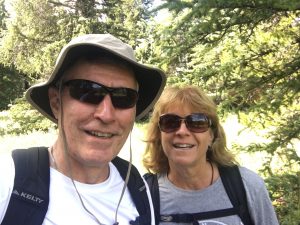
For several years, I’ve had my eye on an unnamed summit (12132) in the Buffalo Peaks Wilderness Area (W0C/SP-055). No one had activated it for Summits On The Air (SOTA) probably because the summit is somewhat remote. I originally thought I would have to do many miles of bushwhacking from the north to get to get to the top. After studying a few maps and trail descriptions, I eventually found a route from the east that is not too difficult.
My hiking partner Joyce/K0JJW and I started at Lynch Creek Trailhead, which is about 9 miles west of Highway 285 on FS 431, also known as Buffalo Peaks Road. The USFS Pike National Forest map is a good reference for finding the trailhead. We followed Salt Creek Trail #618 for about 1 mile to connect to the Tumble Creek Trail #617. These are well-used and well-maintained trails and a joy to walk on. We had been doing too much off-trail hiking lately, so this was a very nice change. The trails are marked by signs at the junction and are easy to follow.
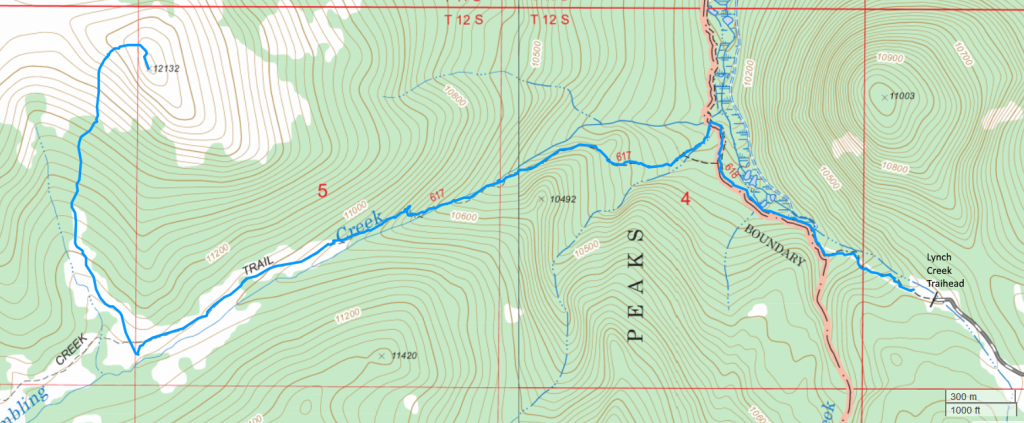
We considered ascending the east side of the mountain but concluded that we’d end up hiking through some dense forest, which usually means downed timber and slow progress. Instead, we approached the summit from the south, leaving Trail 617 about three miles in from the trailhead, and heading uphill through a grassy meadow. There is a large beaver pond to the south at the point where we left the trail, so that makes for a good landmark. You can’t completely avoid the trees on this path but they are sparse enough to easily walk through. Near the summit, the easiest path hooks around to approach the summit from the west, avoiding some steep rocks on the south side of the summit. (Actually, we went straight up the rocks on the ascent and decided to avoid them on the descent.)
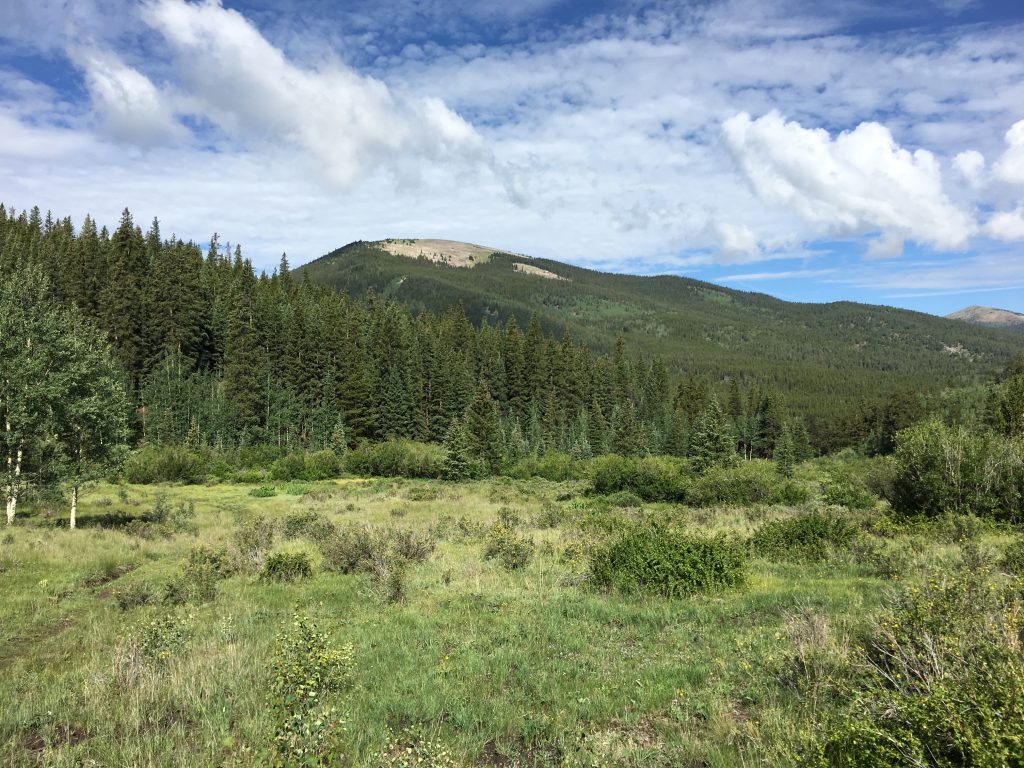
The summit is above treeline and relatively flat, offering excellent views in all directions.
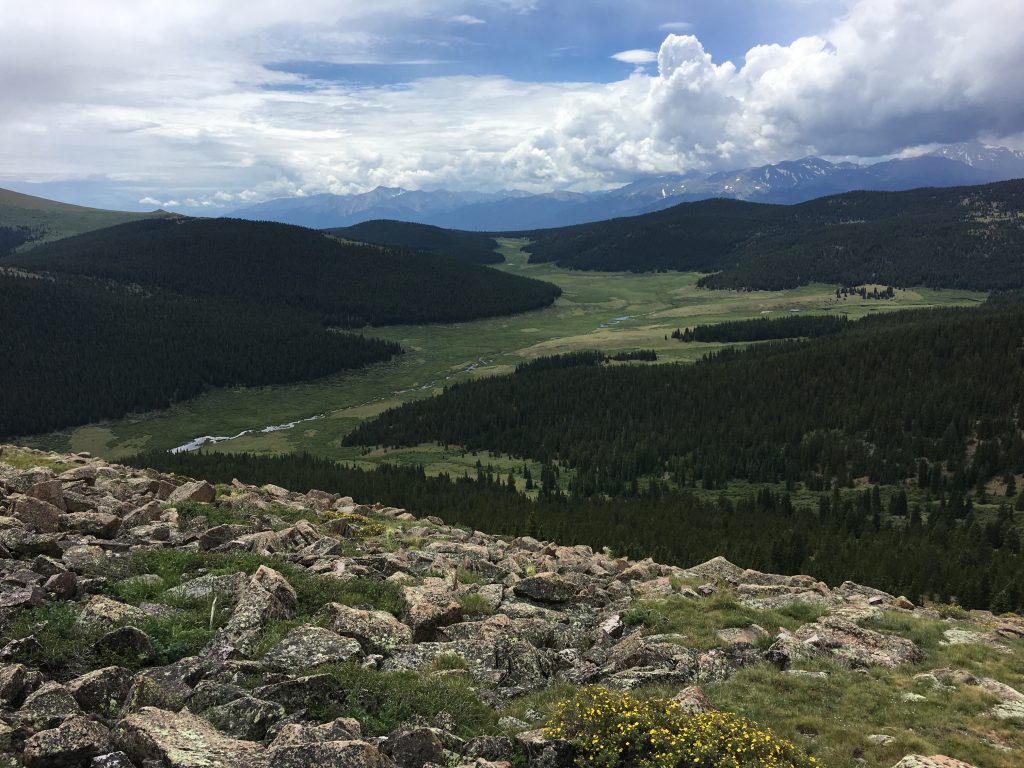
Joyce and I both got on the air and made calls on 146.52 and 446.00 MHz using handheld VHF/UHF radios. We just used vertical antennas and didn’t bother to assemble the yagi antennas. Thanks to these stations that we worked that day: W0BV, W0DLE, N0VXE, K0RCW, K9LNH and KD0VHD.
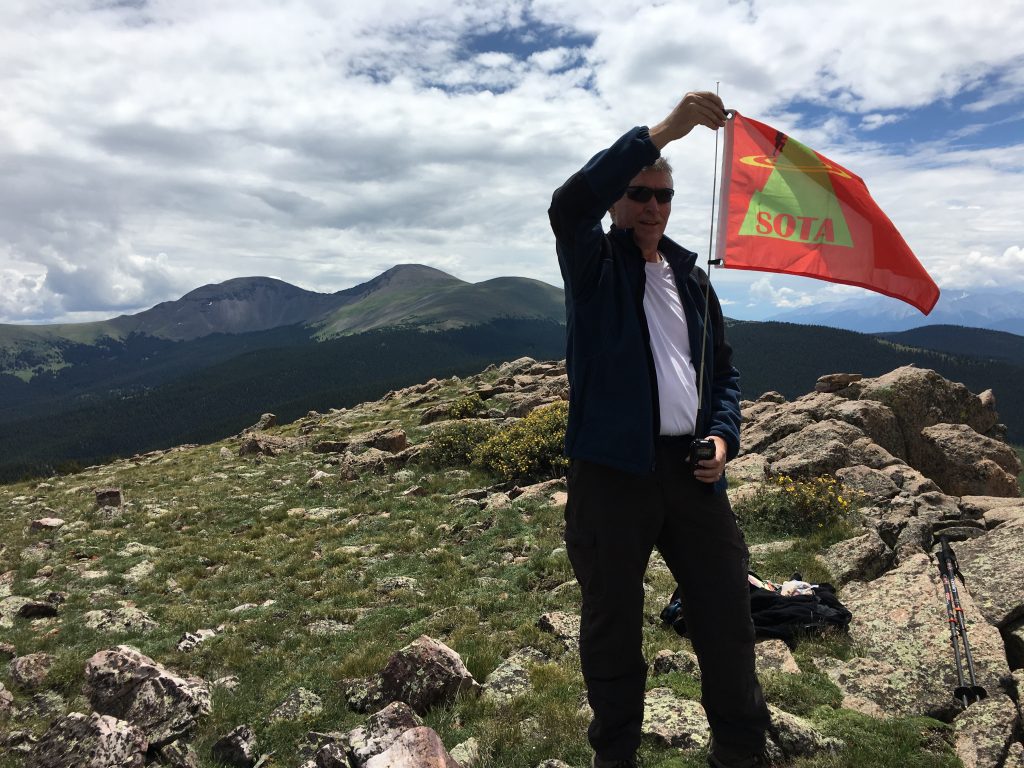
The GPS app on my smartphone indicated the one-way distance at just under 4 miles, with an elevation gain of 2000 feet. The actual elevation gain may be slightly more than that due to some ups and downs on the trail. This is one of those hikes that we’ll probably do again in the future. It has an enjoyable mix of good trails, rolling streams, green meadows, great views and a pleasant summit.
73, Bob K0NR
The post First SOTA Activation for W0C/SP-055 appeared first on The KØNR Radio Site.
Bob Witte, KØNR, is a regular contributor to AmateurRadio.com and writes from Colorado, USA. Contact him at bob@k0nr.com.
 Flight of the Bumble Bee QRP contest
Flight of the Bumble Bee QRP contest
| Setting up |
| The view from the op table |
| Setting up the loop |
| The outdoor shack. |
| Chameleon CHA P |
| Fuelling up before |
Mike Weir, VE9KK, is a regular contributor to AmateurRadio.com and writes from New Brunswick, Canada. Contact him at ve9kk@hotmail.com.
 Flight of the Bumble Bee QRP contest
Flight of the Bumble Bee QRP contest
| Setting up |
| The view from the op table |
| Setting up the loop |
| The outdoor shack. |
| Chameleon CHA P |
| Fuelling up before |
Mike Weir, VE9KK, is a regular contributor to AmateurRadio.com and writes from New Brunswick, Canada. Contact him at ve9kk@hotmail.com.
 The Spectrum Monitor — August, 2017
The Spectrum Monitor — August, 2017
 Stories you’ll find in our August, 2017 issue:
Stories you’ll find in our August, 2017 issue:
Rocky Mountain Ham Radio Microwave Backbone and DMR Repeater Network
By Wayne Heinen N0POH
The Rocky Mountain Ham Radio deployed analog repeater sites all along the Front Range of Colorado and had been linking them via the Internet for years. Due to the cost and reliability factors of commercial Internet, the club had been looking for a ham radio spectrum-based transport method for their IP needs which have been steadily growing over the years. What was needed was a digital link that could be created between the various mountain top sites, an IP based network of their own design that would be controlled by the club. Wayne explains how they did it.
Intro to Scanning Today
By Bob Grove W8JHD
The requirements of scanner listeners have been changing since the very first radios capable of tuning the public service bands were manufactured. While some analog scanners available today are still useful, many listener in more urban areas need significant upgrades to their listening posts to continue listening. Bob explains which radios are best for each technology today.
TSM Reviews: W4OP Loop Antenna
By Thomas Witherspoon K4SWL
Last year Thomas caught a bug: the National Parks on the Air (NPOTA) bug. He found NPOTA the perfect excuse to play radio outdoors. From August to December 2016, he activated ninety-one NPOTA National Parks running QRP (low power). To do so he needed a stand-alone antenna small enough to set up easily, rugged enough to do so many times and capable enough to make contacts from some very remote spots. The W4OP loop filled the bill.
Using Weak Signal Modes for Propagation, RFI, and Antenna Analysis
By Robert Gulley AK3Q
Digital mode operating has changed everything for many hams looking for a way around the disappearing solar cycle. WSJT-X weak-signal software, which includes JT65, JT9, MSK144, JT8 and other specialized transmission modes for moonbounce, meteor scatter and aircraft scatter has extended two-way amateur communications on bands that otherwise might not be used. Robert has also discovered that these programs are an excellent resource for identifying and studying propagation, Radio Frequency Interference (RFI) and antenna characteristics.
US TV Channel Assignments: Part 3
By Mike Kohl
This third installment in the series on the repacking of the TV band continues with the identification of significant communities within each designated marketing area (DMA). Markets numbering from 151 to 248 are covered this month.
Scanning America
By Dan Veeneman
Winnebago County (IL), Broward County (FL)
Federal Wavelengths
By Chris Parris
Joint Base Lewis McChord, Washington
Utility Planet
By Hugh Stegman
Watching the Eclipse with a Radio
Shortwave Utility Logs
By Hugh Stegman and Mike Chace-Ortiz
VHF and Above
By Joe Lynch N6CL
Honey, I Shrunk the Loop
Digital Voice
By Cory Sickles WA3UVV
Feels Like the First Time
Amateur Radio Insights
By Kirk Kleinschmidt NT0Z
RG-6: It’s Still a Steel
Radio 101
By Ken Reitz KS4ZR
Connection Complications: Troubleshooting 101
Radio Propagation
By Tomas Hood NW7US
Coronal Mass Ejection Science
World of Shortwave Listening
By Rob Wagner VK3BVW
The Use and Abuse of SINPO
The Shortwave Listener
By Fred Waterer
Radio from Four Continents via Shortwave and Internet
Amateur Radio Astronomy
By Stan Nelson KB5VL
New Callisto Devices
The Longwave Zone
By Kevin O’Hern Carey WB2QMY
630-Meter Band Plan Takes Shape
Adventures in Radio Restoration
By Rich Post KB8TAD
Heathkit HG-10B VFO
Antenna Connections
By Dan Farber AC0LW
Stealth: A Philosophy and a Methodology
The Spectrum Monitor is available in PDF format which can be read on any desktop, laptop, iPad®, Kindle® Fire, or other device capable of opening a PDF file. Annual subscription is $24. Individual monthly issues are available for $3 each.
Ken Reitz, KS4ZR, is publisher and managing editor of The Spectrum Monitor. Contact him at editor@thespectrummonitor.com.
 Win 1,000 Free QSL Cards!
Win 1,000 Free QSL Cards!
AmateurRadio.com is offering a free prize drawing!
With the help of our generous sponsor, KB3IFH QSL Cards,
we’re holding a giveaway for 1,000 free full-color premium photo QSL cards.
This is a US$121 value and open to all licensed hams in the USA.
Matt Thomas, W1MST, is the managing editor of AmateurRadio.com. Contact him at editor@amateurradio.com.














